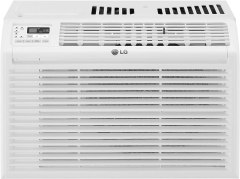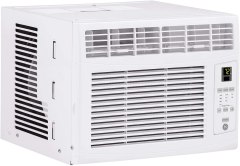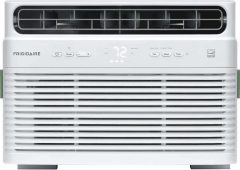Buying guide for best window air conditioners
Keeping your home cool in hot weather can be challenging if you don’t have central air conditioning. But that doesn’t mean you’re doomed to a sweaty, intolerable summer. A window air conditioner can effectively cool a room or area, and it isn’t a permanent fixture, so you can easily remove it at the end of the season.
As the name implies, a window air conditioner sits in a window frame so the back of the unit is outside. It draws warm air out of the room, cools it and recirculates it to lower the room’s temperature. Excess warm air is vented to the outside from the back of the unit. A window air conditioner can also remove moisture, making your home less humid.
A window air conditioner isn’t the best option if you need to cool an entire house, but it can be highly effective in a small space like a bedroom. When shopping for one, it’s important to keep in mind the noise level (anything under 60 decibels is considered to be on the quiet side), whether it’s powerful enough to cool the space (see our section on cooling power below for tips on how to calculate this) and whether it offers energy-efficient features to save you money on electricity.
With user-friendly controls and plenty of convenient settings, the LG 6,000 Btu Window Air Conditioner with Remote Control tops our list of best window air conditioners. If you’re looking for a more affordable model with similar features, we like the GE Appliances 6,000 Btu Electronic Window Air Conditioner, which boasts several fan and cooling modes to get your room as comfortable as possible.
Window air conditioners
If you want a window air conditioner for a bedroom, this easy-to-use model offers 6,000 Btu of cooling power, enough to handle up to 250 square feet. In addition, it has three fan speeds and two-way air deflection, so you can customize the airflow and keep your room comfortable as you sleep. To save energy, this model has a 24-hour timer that lets you choose when it turns on and off to maintain the perfect temperature. The user-friendly digital control panel makes it easy to adjust settings, and there’s a remote for when you don’t want to get out of bed. Best of all, it won’t interrupt your sleep. It operates as low as 52 decibels, so it’s one of the quieter models on our list.
Another effective model for the bedroom, this efficient window air conditioner cools a space up to 250 square feet. It’s easy to install with the included kit, so you can start using it right away. With three cooling modes and three fan speeds, it also offers plenty of versatility to keep your room at your preferred temperature. The digital controls make it easy to change settings and choose the right temperature, and it comes with a remote for across-the-room operation. You won’t have any trouble cleaning the filter: it slides out, so you can wash it every month to keep the unit working effectively. This unit offers an energy-saving mode to help reduce energy costs as well. It produces noise between 52 and 61 decibels, depending on the setting.
If you want a powerful window air conditioner that won’t keep the whole household up, look no further than this 10,000 Btu model. It can handle a room up to 300 square feet, but it operates as low as 42 decibels on the lowest setting, making it the quietest model on our list. For greater convenience, it’s WiFi-enabled, so you can control the settings with voice commands using Alexa or Google Assistant or outside your home with your smartphone and the connected app.
This is also one of the more energy-efficient units, offering up to 35 percent energy savings compared to similar window air conditioners, earning the Energy Star Most Efficient 2022 Certification. But what really sets this model apart is its unique U-shaped design that, when installed, lets you open the window. That means you can get fresh air whenever you want and continue to enjoy the view.
With seven temperature settings, two cooling modes and two fan-only modes, this air conditioner gives you plenty of control when cooling a smaller space. It provides 5,000 Btu of cooling power, making it ideal for a room up to 150 square feet. It also features two-way air direction, so you can get the ideal amount of cooling every time. Installation is easy. It includes all the mounting accessories and requires no tools other than a screwdriver. It also has easy-to-use knob controls and a removable, reusable filter that can be washed. This unit is one of the most affordable on our list, making it a solid choice for a dorm, studio apartment or small bedroom. The AC operates at between 54 and 57 decibels.
If you’re on a budget, this efficient window unit is another top choice. It offers 5,000 Btu, making it ideally suited for a small room. You don’t have to worry about struggling to keep the room at a steady temperature because it maintains a preset room temperature automatically. The user-friendly control panel makes operation a breeze, and it has an extra-long cord so you don’t need an extension cord. Maintenance is also easy with this model. It has an accessible reusable, washable filter that captures dust to keep it performing efficiently. This model operates at 52 decibels.
This impressive air conditioner stands out because it’s the only one on our list that also offers heating for year-round use. It provides 12,000 Btu of cooling power for a space up to 550 square feet. The four-way air deflection lets you direct the airflow so it goes where you need it most. In addition to two cooling and heating settings, it has a dehumidifying mode to remove moisture from the air and keep your room comfortable.
The digital control panel and remote control are easy to use. This model is also WiFi-enabled, so you can use your smartphone to control the settings via the LG ThinQ app, as well as adjust the temperature with voice commands using Alexa or Google Assistant. You’ll have an easy time remembering to clean the filter. A reminder light lets you know when it’s due for washing. This AC unit runs at 54 decibels.
If you’re searching for a powerful air conditioner that can handle a larger space, this model provides 14,000 Btu of cooling power for a space up to 800 square feet. In addition, it offers four cooling modes and fan speeds, plus a dehumidifying feature to always keep your home comfortable. The LED display and LCD remote make it easy to control. It’s also WiFi-enabled, allowing for remote control via the smartphone app or voice commands with Alexa and other smart home devices. This unit is 35 percent more energy efficient than Energy Star Certification requirements, so you’ll also save some money on energy costs. The inverter compressor operates as low as 44 decibels.
What to know before buying a window air conditioner
Cooling power
A window air conditioner’s cooling power is typically measured in British thermal units (Btu). Room size and Btu go hand in hand: large rooms require higher Btu ratings for efficient cooling. As a general rule, you should aim for 20 Btu for each square foot of living space in a two-person home. According to Energy Star, add 600 Btu for each additional person occupying the home.
Kitchens require about 4,000 extra Btu to compensate for the heat generated by cooking. Some manufacturers do the math for you, providing information about the square footage their products can support. Btu specs are listed in the product description or the product’s in-depth specifications.
Heating
Some window air conditioners offer a heating mode in addition to their cooling capabilities, eliminating the need for a separate space heater. Instead of removing hot air from the room, it pulls the cold air out, warms it and cycles it back into the room. The heating function usually allows you to set a desired temperature as you would for the cooling mode, and the unit then turns on and off as necessary to maintain that temperature.
Energy efficiency ratio
Consumers appreciate the most efficient setup when it comes to appliances that require a lot of electricity to run. To maximize energy efficiency and energy savings, look for a unit with a high energy efficiency ratio. This is determined by considering both the Btu rating and the wattage of the unit. In addition, make note of options that are Energy Star certified. This certification indicates that the appliance meets the EPA’s guidelines for energy efficiency.
Thermostat
Some units have a built-in thermostat (in most cases located behind the control panel) to detect the temperature of the room and adjust the air conditioner’s output according to your settings. This saves energy by preventing the unit from running constantly if you forget to adjust the temperature setting. When you install your unit, take note of whether there are any nearby lights that may warm the front and cause the thermostat to have an inaccurate reading.
Many units without thermostats are less expensive and simply have different cooling settings. They won’t turn on or off when the room reaches a certain temperature. Rather, it’s up to you or a timer to turn the unit off. Some have timers in place of thermostats, allowing consumers with a predictable schedule to program the timer to run the air conditioner before they return home. For example, you could program the unit to start running half an hour before you arrive home in the evening.
Size, installation and storage
When looking for the right window air conditioner for your home, start by measuring the width and height of the window you plan to use. Look for two main dimensions in the product descriptions: minimum and maximum window width and window height. The wrong size window air conditioner means the window seal won’t fit properly or the unit won’t fit in the window at all.
Also note the weight of the unit and how it’s installed in the window to determine whether you’ll be able to install it on your own. If possible, position the unit out of direct sunlight. An air conditioner that’s shaded from the sun doesn’t have to work as hard and may last longer.
Check local laws and ordinances before you buy a window unit. Some areas may forbid them, and other areas (particularly cities) might have requirements for how window units can be installed. For example, they might require the use of brackets for extra support, or you could be required to have management install the unit.
Storing your air conditioner properly when it isn’t in use can also help extend its life. Remove the appliance from the window during cool seasons and keep it in a dry place. Cover it to protect it from dust.
Fan speed
Fan speed matters because it affects how soon you begin to feel relief on a sweltering summer day. The speed of the fan determines how quickly cool air spreads throughout the room. In many cases, you can control the fan speed of a window air conditioner with the turn of a dial. Most manufacturers don’t provide specific measurements or figures when it comes to fan speed, but they’ll indicate the number of speed settings the unit offers.
Consider turning off the cooling mode and leaving the fan on when the outside temperature is lower than the room temperature, allowing nature to do the cooling and potentially lowering your energy bill. Evenings, nights and mornings are the best times to run just the fan.
Vents
The slats of the swivel vents on an air conditioner can be adjusted, allowing you to control the direction of airflow. This is particularly helpful if you have an oddly placed window and want the air to move to the center of the room instead of one side. They’re also nice if you want the cold air to flow directly on or away from you.
Noise level
Window air conditioners have a reputation for being noisy, but many newer models are designed to reduce the noise to avoid disturbing your sleep. More affordable window units with a standard compressor usually operate at 50 to 60 decibels on the lowest setting. However, high-end window air conditioners with an inverter compressor can run at decibel levels in the 40s on their lowest setting. Normal conversation is typically about 60 decibels, so an inverter window air conditioner often sounds like white noise that may even help you sleep.
Remote control and companion app
Many of today’s air conditioners come with a remote control. You can use it to adjust the settings from anywhere in the room. Not all window units include a remote, but if you’re in a busy work environment, have a window that’s hard to access, have limited mobility or just don’t want to get up to adjust the settings, a remote can be a desirable feature.
Other units might have a companion app that lets you adjust the temperature with your smartphone. In some cases, you can turn the air conditioner on or off when you’re away from home.
Air filter
The air filter on an air conditioner helps purify the air that passes through the appliance by removing dirt and dust. Many air filters are replaceable or reusable. Washable filters are a more economical choice since they can be used again and again. If you live in an area that is dry or dusty or has reduced air quality, consider a unit with a washable filter to save time and money.
Tips
The average window air conditioner lasts about a decade. Like most appliances, the lifespan of your unit will depend on how well you take care of it. Follow these maintenance tips for optimum air conditioner efficiency.
- Inspect the coils to increase airflow and cooling capacity. Reference the manual to confirm the location of the evaporation coils and follow the manufacturer’s recommended steps. Vacuum the coils with a brush attachment, and take care of stuck-on dirt with a scrub brush.
- Clean the filter regularly. The filter must be clean for the unit to perform its job well, and a dirty filter can slow down the appliance. You can access the filter on most air conditioners by removing the front grille. Clean the filter or replace it if it can’t be washed.
- Look for and fix bent coil fins. The coil fins are the narrow metal strips that form the grooves in the air conditioner. Bent fins can lower the unit’s energy efficiency. Running a fin comb through the fins can straighten any bent ones.
FAQ
Q. How much does a window air conditioner cost?
A. It depends on the size of the area you need to cool and what features are most important to you. A basic unit for smaller rooms that operates at around 5,000 Btu usually costs $100 to $200. If you want to cool a larger area with 8,000 to 12,000 Btu and want special features like remote access, you can expect to pay $200 to $350. For the most powerful window air conditioners with 15,000 to 23,000 Btu, special features like smart home access and heating capabilities, you’ll typically pay $350 and more.
Q. How is a window air conditioner better than central air, HVAC or a portable air conditioner?
A. One of the biggest advantages of a window air conditioner is the lower upfront costs. Whereas central air conditioning systems and HVAC systems can cost several thousand dollars, a window unit only costs a few or several hundred dollars. What’s more, because these units sit in the window, they don’t take up precious floor space.
Portable air conditioners are convenient because they can be moved from room to room, but they’re generally less efficient than window units. Ductless mini split air conditioners are much more efficient than window units, but like central air systems, they come at a higher price and are more challenging to install.
Q. How much maintenance does a window air conditioner require?
A. You might need to clean or replace the air filter from time to time, but other than that, window air conditioners require little maintenance. We do advise owners to occasionally clean the evaporator and condenser coils and straighten bent fins with a fin comb. You should never have to add refrigerant, however.
Q. I’m sensitive to noise. Are window air conditioners noisy?
A. Older models were certainly noisy, and some cheaper air conditioners could put out some noise. But manufacturers now are far more conscientious about the noise level of their products. You don’t have to purchase a window air conditioner without knowing what to expect in terms of noise. Simply check the decibels of a unit if sound is a major factor for you.
Q. Can I leave my air conditioner in place during cold months?
A. If you live in an area that sees temperatures below 60 degrees, you should never leave a window unit in place during the fall or winter. Why? Not only can this type of exposure damage or destroy the unit, but it can also let cold air into your home. Instead, remove the air conditioner from the window and store it in an upright position somewhere that isn’t susceptible to moisture or temperature changes.

































